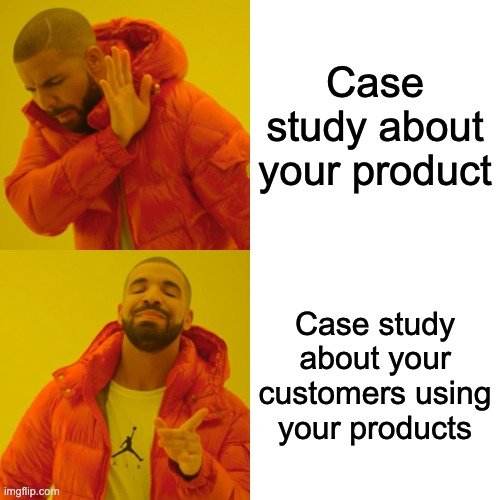Prove Your Value with Case Studies
Let’s say you’re thinking of buying AI-powered accounting software for your business. You’re reading through the software’s website and you’re not completely convinced. Which of the following messages would better persuade you to make a decision? “Slack saves $28M per year with this AI accounting platform” or “Save millions of dollars with our accounting platform.”
The first message is more persuasive. Slack is a reputable company you’ve probably heard of, $28M is a significant number (even for a well-known company), and this is a real-world piece of information without any marketing fluff. I don’t know about you, but I want to learn more about how they saved that $28 mill.
That’s the beauty of a good case study: it tells a story about how someone successfully used a product in an interesting, relatable way. Prospective buyers want to hear these stories when they’re considering your product. They want to put themselves in your customers’ shoes and imagine their own successful future thanks to the use of your product. They want you to convince them that giving you money will lead to a great result. They don’t want to read vague messages about features and hypothetical benefits.
Case studies are real-world transformation stories that persuade people to buy. Let’s dig into why they work and how to write one.
Why case studies work
A case study proves that your product actually does what you say it does. It’s an opportunity to provide an actual-factual story in a world mired with non-specific promises like “save money” or “increase productivity” or “generate more leads.”
Case studies demonstrate the causal relationship between the use of your product and a realistic, achievable result. For instance, we sell technical content marketing and ghostwriting. Our work goes beyond the typical “increase SEO” or “grow organic traffic” results our competitors promise. Our content led to a client’s acquisition by a larger competitor. We’ve written articles that hit the front page of Hacker News. We’ve written ebooks that’ve made it to the C-suite at companies like Mastercard and Black Rock.
Our content is valuable, high-quality, and gets results. That’s why our clients hire us—and why you should consider working with us. See how this works?
The better you can prove that your product causes a beneficial result, the easier it is to sell. This is especially true when you have a gallery of case studies that show off many of your customers’ successes.
A case study is a story
At its core, a case study is a story in which your customer is the main character. They overcome conflict using your product to solve a business problem and achieve a successful result. Your prospects want to read this story to learn whether your product can also solve their problem.
I recently wrote a case study for a client showing that their customer saved 1,000 hours of software development time and increased productivity. That “1,000 engineering hours” stat is powerful, but it’s just the headline. The actual story centers around two analytics engineers (actual people with names) who used my client’s product to replace spreadsheet-based data issues with speedy and sophisticated data integrations.
It’s not enough to say, “Company X purchased Product Y and got Result Z.” You have to articulate the pain points that created the conflict that led to the purchase of Product Y. Then you have to share the ups and downs of the journey that got them to Result Z. That makes the case study psychologically fulfilling and emotionally enjoyable.
A case study is not about you
It’s easy to forget that case studies are stories about your customers—not about you. When you’re writing about your products and services, you might get tunnel vision or emotionally wrapped up in how you helped people. There’s nothing bad about that, but it doesn’t make for a good case study.
Your case study should tell the story of your customer’s success. Yes, they used your product. Yes, your product enabled them to achieve a result. No, the case study is not about you or your product (even though it is).
A prospect wants to read about other people being successful because they want to believe they’ll see similar success. When you make the story about yourself or your product, you’re preventing your reader from putting themselves in the shoes of your customers.
Good headline: “Slack saves $28M with our accounting software”
Bad headline: “Our accounting software helped Slack save $28M”
Don’t make it about you. Make it about your customer. You’re just a part of the story.
Getting the story before writing the story
To get your customer’s story, you have to talk to them. That means you’ve got to interview them and actually hear the story directly from them, in their own words. You need to ask questions that help them to demonstrate (or at least correlate) how your product helped them achieve a successful result.
This is tough work.
Often, your customers may not even know their own story. They’re too wrapped up in technical details or they might not have much visibility into the business side of things. Or, maybe you’re going into the conversation with an angle, like, “Tell me how you used our product to increase sales.” If your angle isn’t aligned with theirs, they’re not going to tell the story you’re hoping for.
I like to joke with my clients that writing a case study isn’t actually “technical content marketing,” but “creative investigative journalism.” Sometimes you walk away from a customer interview with nothing better than, “Okay, well Chuck kinda likes our product, I guess?”
The art of interviewing your customers warrants its own entire article, but for now, here are some tips:
Always record these conversations
Ask open-ended questions
Let them talk as much as possible
Don’t get in the way by pressuring them to speak to a specific point
If they hint at a result, then get very specific
Remember: you want your customers to share positive stories about your product, so do everything you can to make them feel good about sharing those experiences.
Compelling case studies resonate with your reader
We’ll get into writing the case study in another article, but for now remember the following:
Case studies are persuasive stories about your customers’ real-world success using your product or service
Case studies are about your customer, not about you or your product
The people reading case studies are potential customers
It’s your job to present your customer’s success in an engaging and relatable way so your readers connect with your customer
A compelling case study showcases your product’s effectiveness by telling a story that resonates with your prospects. It’s not an excuse to boast about your product, but to demonstrate how real people overcome real challenges and achieve remarkable results. By focusing on authentic, relatable stories, you validate your product's value and build a deeper connection with your audience.
So, as you embark on creating your next case study, focus on the human element, the tangible impacts, and the relatable journey of success. That's the story that will capture attention, inspire confidence, and ultimately, drive action.
Need help with a case study? Just reach out. We’re happy to chat.

